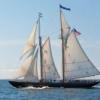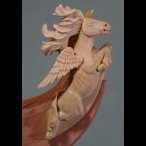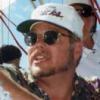-
Posts
655 -
Joined
-
Last visited
Reputation Activity
-
 rlb got a reaction from Elia in US Brig Oneida 1809 by rlb - The Lumberyard - 1:48 scale - POF - Lake Ontario Warship
rlb got a reaction from Elia in US Brig Oneida 1809 by rlb - The Lumberyard - 1:48 scale - POF - Lake Ontario Warship
Continuing on--
After all the futtock plates were made and blackened, the deadeyes were crimped back in, and being held firmly, this was a good time to refine them with the easing of the lanyard holes--
Next the futtock plates and deadeyes were installed on the tops. I contemplated the light colored deadeyes, wondering if I had made a mistake to make the ones on the channels black. But the die (dye) had been cast, and the top deadeyes were blackened (in situ) to match--
You can also see some blocks hanging below the tops. You can't tell, but the outside one is single, and the inner double. I initially had three blocks on each side and they looked too crowded together, so I eliminated the middle one on each side. I'm not sure I can really do that though. I'm sorting through the rigging requirements (which are overwhelming), and I think I will have to put the middle block back. The outer blocks are needed for the spritsail, and the others for the bunt and leech lines of the yards on the mast, so four sheaves on each side needed, at least for the fore top, I believe. I'm going to do single, single, double, on each side. Theoretically maybe it could be double, double, but it doesn't seem right to combine the spritsail block with one for the main yard.
While I study rigging, and some other bits and pieces that need to be added to the tops, I'm making the trymast. The trymast is a secondary mast on the aft side of the mainmast where hoops for the boom sail (placeholder while I look up the correct name) will travel.
I've got the trymast, and the start of it's support from a piece of scrap--
This is further shaped, and test fit to the mast--
The support bracket needs some support brackets of it's own. And I have to figure out how the trymast and the top resolve themselves.
All for now,
Ron
-
 rlb got a reaction from Elia in US Brig Oneida 1809 by rlb - The Lumberyard - 1:48 scale - POF - Lake Ontario Warship
rlb got a reaction from Elia in US Brig Oneida 1809 by rlb - The Lumberyard - 1:48 scale - POF - Lake Ontario Warship
Thanks Ed. Yes, my shop has grown enormously from the first days. I cut the original masts from a billet with a jewelers saw, and spent hours (days) sanding them flat and square. Now it's a few minutes work. But I spend most of my time still with files, chisels, and sand paper.
I'm getting the fore and main tops ready. One of the tasks is making the futtock plates for those deadeyes I showed in the last post. I used the method described by David Antscherl in Vol. 4 of The Fully Framed Model.
Here is the test piece, and a bunch of square wire cut for the rest--
The wire I bought was supposed to be "dead soft" meaning it should be not spring back when bent, but I found I still had to heat it red hot to make it truly malleable. The wire pieces were bent around a drill--
They were then silver soldered at the "bottom" end. This would allow them to be bent back apart to insert the deadeyes. This shows a series of them ready to solder. You can just see the dab of solder paste about halfway along each piece--
.
That arrangement didn't work so well. Only three of the pieces soldered well, because when liquid, the silver followed gravity rather than the gap in the wire.
Turning the pieces this way worked better--
Here are some ready to be soldered, some successfully soldered and filed smooth, and some cut to length with a hole drilled for a hook--
All for now,
Ron
-
 rlb got a reaction from Elia in US Brig Oneida 1809 by rlb - The Lumberyard - 1:48 scale - POF - Lake Ontario Warship
rlb got a reaction from Elia in US Brig Oneida 1809 by rlb - The Lumberyard - 1:48 scale - POF - Lake Ontario Warship
I thought I would share my method for making deadeyes.
I made a bunch a long time ago for the main and fore shrouds, and half what I needed for the topmast and topgallant backstays. They were about 5mm and 4mm respectively. I made them using a method described in Underhill's book, and it worked out fine. The little jig is very fiddly to make. The method is shown from post #184-198 in this log.
However I now need 32 topmast shroud deadeyes at 3.5mm, and 12 more of the backstay deadeyes at 4mm. Partly because of the smaller size, and partly because I have better tools now, I wanted to try something that might be more precise.
This first batch is the 3.5mm set. I turned a squared piece of pear down to 3.5mm, and then scored it on the lathe with grooves for the futtock plates, and cut-very slight cut off grooves to help with parting them off with a saw. While the dowel was still on the lathe, one by one, I smoothed and rounded the outer edge, then cut it off. I didn't take pictures but here is the result--
You can see they have one smooth side, one rough side, and a groove. (Noticeable on one of the deadeyes standing on edge.)
Next I drilled a hole in a piece of scrap wood just under 2mm thick (the thickness the finished deadeye needs to be), filed the hole to to 3.5mm diameter, and glued it to another piece of scrap wood. This has a smaller hole drilled through it centered on the larger hole--
A deadeye fits very snuggly in the hole, the rough side slightly proud--
The rough edge is filed off flush with the surface of the wood--
I filed the one shown below just a bit more with a smaller file after taking the photo--
I then marked by eye the spots for the holes to be drilled--
And drilled them on a mill. I wasn't great at locating the drill precisely at the marks, so I tried drilling a couple by hand. I could get the drill in the mark very easily that way, but at that small size, my accuracy (keeping the pin vise vertical) wasn't good enough.
After some practice with the mill, I could locate the drill above the punched markings more quickly and pretty accurately--
The deadeye is then pushed out from behind--
And the flattened surface is rounded off with a file--
Here are two finished--
It took me about 5 before they started looking good. The first few had problems with my marking of the holes with the right spacing, as well as the stated problem with hand drilling them. I started with one spare, so I'll ponder whether the first are okay to use, or if I have to turn a few more blanks.
All for now,
Ron
-
 rlb got a reaction from Elia in US Brig Oneida 1809 by rlb - The Lumberyard - 1:48 scale - POF - Lake Ontario Warship
rlb got a reaction from Elia in US Brig Oneida 1809 by rlb - The Lumberyard - 1:48 scale - POF - Lake Ontario Warship
Thanks JJ,
Going off course a little bit, I worked on making some closed hearts for the bowsprit stays and shrouds--
I need two different sizes--4 for the stays, and 4 slightly smaller for the shrouds. After doing a few after cutting them off, I realized it would be much easier to shape them before cutting them off--
Now I need to make a bunch of deadeyes for the topmast shrouds, as well as the backstays.
All for now,
Ron
-
 rlb got a reaction from Elia in US Brig Oneida 1809 by rlb - The Lumberyard - 1:48 scale - POF - Lake Ontario Warship
rlb got a reaction from Elia in US Brig Oneida 1809 by rlb - The Lumberyard - 1:48 scale - POF - Lake Ontario Warship
The masts have all been shaped, and fid holes and sheave holes cut into them in various places also. I blackened using my usual method (shown a few times earlier in this log), and here they are--
They are not completely finished. Tung oil finish is only partly applied, as part of the procedure to minimize bleed of the staining. I need to attach some eyebolts to the caps; and the shroud deadeyes and some blocks to the tops, but they can finally be temporarily assembled to see how they look--
And on the ship--
Next will be finishing those parts I mentioned earlier, and checking the deck to see if there's anything else that should be done before starting the standing rigging. Also making the rest of the bowsprit, and the trymast that attaches to the aft side of the mainmast. And I'm sure I'll discover additional things that should be done before the stays and shrouds go on!
All for now,
Ron
-
 rlb got a reaction from Elia in US Brig Oneida 1809 by rlb - The Lumberyard - 1:48 scale - POF - Lake Ontario Warship
rlb got a reaction from Elia in US Brig Oneida 1809 by rlb - The Lumberyard - 1:48 scale - POF - Lake Ontario Warship
Thanks, CiscoH, Håkan, davec and JJ, and all who are looking in and liking.
Yes, I like the "workaday" stowed look better than perfectly coiled lines. The inspiration came from seeing how the working carronade on the Niagara replica ship had been tied down. There is a photo of it earlier in this log (post #116), but here it is again--
My take on it is a little different (simpler to accomplish), but retains the idea of wrapping the tackle falls back and forth across the top of the carronade.
The 6-pounder long guns have been installed--
Now it's time to put the ship away again--
And continue work on Oneida's spars--
All for now,
Ron
-
 rlb got a reaction from Elia in US Brig Oneida 1809 by rlb - The Lumberyard - 1:48 scale - POF - Lake Ontario Warship
rlb got a reaction from Elia in US Brig Oneida 1809 by rlb - The Lumberyard - 1:48 scale - POF - Lake Ontario Warship
I spent the last week lashing down the carronades--
At the bow are the tackles for the two 6-pounder cannon, and also their breeching lines.
The two carriages are nearing completion here, black monofilament fishing line was used for the truck "pins"--
After they were finished, fitting the breeching lines was next. One end was lashed to it's eyebolt and temporarily fixed into the bulwark. The line was checked for length, allowing for a loop around the cascabel, and the fastening to the other eyelet--
The cascabel loop was temporarily tied, as well as the first lashing of the eyebolt, and the length was checked again--
As the first breeching line was finished, the second could be made up more quickly using the first as a guide, without needing to check it in place on the ship--
I've reached my stopping point for the day.
Ron
-
 rlb got a reaction from Elia in US Brig Oneida 1809 by rlb - The Lumberyard - 1:48 scale - POF - Lake Ontario Warship
rlb got a reaction from Elia in US Brig Oneida 1809 by rlb - The Lumberyard - 1:48 scale - POF - Lake Ontario Warship
Thanks, JJ.
Now that I have finished stropping the blocks, the ship comes out on to the table for rigging the carronades, and two 6-pounder cannon--
.
Tackle lines have been cut, dyed a little darker, and are in process of tying to an eyelet in one of each pair of blocks--
I had assembled one of the 6-pounder cannon carriages a while ago, now I need to assemble the other one, as well as finish the first with cap-squares, breeching rings and other eyelets. I have two extra axles pieces here!--
All for now,
Ron
-
 rlb got a reaction from Elia in US Brig Oneida 1809 by rlb - The Lumberyard - 1:48 scale - POF - Lake Ontario Warship
rlb got a reaction from Elia in US Brig Oneida 1809 by rlb - The Lumberyard - 1:48 scale - POF - Lake Ontario Warship
Thanks Håkan.
Only a few photos today, but I'm happy to report that I worked up the motivation to finish the carronade tackle blocks. This shows the 13 sets that were done, and last four sets (16 blocks) I still needed to do--
The total here is 17 sets, because one is on the already rigged carronade that has been on the ship for years. And here they are done--
That was probably the least pleasant task I have had to do on the build so far (literally taking me years of off and on work), and I'm glad they are finished!
And here is one of the topgallant masts roughed out, next to a topmast, and the other topgallant blank--
Next is rigging the carronades, and continuing work on the masts.
All for now,
Ron
-
 rlb got a reaction from Elia in US Brig Oneida 1809 by rlb - The Lumberyard - 1:48 scale - POF - Lake Ontario Warship
rlb got a reaction from Elia in US Brig Oneida 1809 by rlb - The Lumberyard - 1:48 scale - POF - Lake Ontario Warship
Thanks Håkan. I can only guess that when they were assembling that page of the book, the true scale illustration just looked too small on the page, so they enlarged it and didn't change the caption. Who knows?! Hopefully I will remember to always double check the illustrations.
I finished the trestletrees, and test fit the pieces, checking to make sure they would also fit on the topmast--
Then I made a rudimentary jig to hold the trestle pieces, for gluing the crosstrees. I rarely make these kind of jigs, because I am too impatient and lazy, but it was a good idea to do this, and it only took a few minutes--
I ended up making deeper notches in the trestletrees, and none in the crosstrees, though you can see I had marked some, and even started to cut a couple notches in one of the crosstrees, before deciding it would be wiser to just notch the trestletrees even though not historically accurate. I test fit the crosstrees many time, adjusting the notches in the trestle trees for depth, and to make sure the crosstrees were parallel to each other, and perpendicular to the trestletrees. I then glued the crosstrees in--
The photo makes that first set of notches look very bad. It's not so noticeable in person, but I'll fill the gaps and all will be stained black when done--
There is more work to do now on the topmast: filing a tenon on the end, for the cap, and angling the top of the octagonal haunch so the trestletrees sit parallel to the water line--
Now it's on to the topgallant masts.
Ron
-
 rlb reacted to Elia in Arethusa 1907 by Elia - Knockabout Banks Fishing Schooner
rlb reacted to Elia in Arethusa 1907 by Elia - Knockabout Banks Fishing Schooner
Hi Ron,
It’s good to see you here! I completely understand. I’ll go find your Oneida to check in on it. Mine came home after many years and I now have to find a good place to display it. Fully masted and rigged, and cased, it takes up a non-trivial amount of space.
-
 rlb got a reaction from CiscoH in Arethusa 1907 by Elia - Knockabout Banks Fishing Schooner
rlb got a reaction from CiscoH in Arethusa 1907 by Elia - Knockabout Banks Fishing Schooner
Glad to see you back in the workshop, Elia! I am still working on my Oneida, off and on. More off than on. Last year I thought for sure I would finish, but no, I haven't touched it since last May. Perhaps I will be inspired to continue soon.
Ron
-
 rlb got a reaction from Elia in Arethusa 1907 by Elia - Knockabout Banks Fishing Schooner
rlb got a reaction from Elia in Arethusa 1907 by Elia - Knockabout Banks Fishing Schooner
Glad to see you back in the workshop, Elia! I am still working on my Oneida, off and on. More off than on. Last year I thought for sure I would finish, but no, I haven't touched it since last May. Perhaps I will be inspired to continue soon.
Ron
-
 rlb got a reaction from Keith Black in Arethusa 1907 by Elia - Knockabout Banks Fishing Schooner
rlb got a reaction from Keith Black in Arethusa 1907 by Elia - Knockabout Banks Fishing Schooner
Glad to see you back in the workshop, Elia! I am still working on my Oneida, off and on. More off than on. Last year I thought for sure I would finish, but no, I haven't touched it since last May. Perhaps I will be inspired to continue soon.
Ron
-
 rlb reacted to Trussben in HMS Winchelsea 1764 by Trussben - FINISHED - 1:48
rlb reacted to Trussben in HMS Winchelsea 1764 by Trussben - FINISHED - 1:48
Winchelsea was dusted and cleaned and installed into her final display place in our living room.
Thanks for coming along for the voyage.
-
 rlb got a reaction from Chuck Seiler in US Brig Oneida 1809 by rlb - The Lumberyard - 1:48 scale - POF - Lake Ontario Warship
rlb got a reaction from Chuck Seiler in US Brig Oneida 1809 by rlb - The Lumberyard - 1:48 scale - POF - Lake Ontario Warship
Tonphil1960,
Gregory is basically correct. I started with the Lumberyard "kit", but I have gone far past what you would get if you build the kit as it comes to you. I am using the Chappelle plans and sail plan from the Smithsonian (along with many additional sources for various things) to build a more detailed and nuanced version of Oneida.
Below is a link to the Smithsonian website--
https://americanhistory.si.edu/about/departments/work-and-industry/ship-plans
Good luck!
Ron
-
 rlb got a reaction from FrankWouts in HMS Winchelsea 1764 by Trussben - FINISHED - 1:48
rlb got a reaction from FrankWouts in HMS Winchelsea 1764 by Trussben - FINISHED - 1:48
Beautiful job, Ben! Congratulations!!
Ron
-
 rlb got a reaction from Trussben in HMS Winchelsea 1764 by Trussben - FINISHED - 1:48
rlb got a reaction from Trussben in HMS Winchelsea 1764 by Trussben - FINISHED - 1:48
Beautiful job, Ben! Congratulations!!
Ron
-
 rlb got a reaction from SiriusVoyager in US Brig Oneida 1809 by rlb - The Lumberyard - 1:48 scale - POF - Lake Ontario Warship
rlb got a reaction from SiriusVoyager in US Brig Oneida 1809 by rlb - The Lumberyard - 1:48 scale - POF - Lake Ontario Warship
John and Dan, I enjoyed meeting and talking with you both. Always nice to get to know someone beyond their profile photo and user name!
Mast collars: I started by cutting a bunch of pieces with a 45 degree angle and gluing them together. If I really wanted to get it right, I should have cut 22 1/2 degrees off each side of a piece, to have the wood grain radial. I was satisfied with just showing that the collar is made of eight simulated "wedges"--
These were then sanded roughly round--
Next I drilled out the center, glued in a short piece of dowel, and turned the piece round. After it was round, I drilled the dowel out--
Here you can see I've started roughing out the opening of the first one to fit the fore mast, and other has the dowel glued in--
I used my lathe, but lacking that I could have chucked the piece in a standard drill--
One difficulty was shaping the cut out to accommodate the rather sharp rake of the masts, especially the mainmast. In addition, my shaping of the masts was not perfect, with some variation in the eight sides. That and the rake made it so the collar will only fit on one way (hence the label "F"(forward) on each collar. Each one broke apart at least once as I was chiseling it out. That ended up being a good thing, as the joints became a little more pronounced after regluing. One down, one to go--
Here are some photos of the masts with the collars dry fit on deck--
I believe that is now a wrap for the hull and deck. I am not going to redo the gratings--the holes are only a tiny bit too large. They should be no bigger than 2 3/4", and they are 3". So with that, it's time to start making rope for the standing rigging.
All for now.
Ron
-
 rlb reacted to shipmodel in US Brig Oneida 1809 by rlb - The Lumberyard - 1:48 scale - POF - Lake Ontario Warship
rlb reacted to shipmodel in US Brig Oneida 1809 by rlb - The Lumberyard - 1:48 scale - POF - Lake Ontario Warship
Tonphil -
If you are a maritime history buff, as I am, you should look for a very readable book on the building of Oneida (one of the midshipmen in the construction corps was the later famous writer James Fennimore Cooper) and her distinguished actions during the first battle of Sackett's Harbor (NY) when she is said to have fired the first shot in the War of 1812. If you can, find the obviously named book - The Battle of Sackett's Harbor, 1813 by Patrick A. Wilder.
Best of success
Dan
-
 rlb got a reaction from KentM in US Brig Oneida 1809 by rlb - The Lumberyard - 1:48 scale - POF - Lake Ontario Warship
rlb got a reaction from KentM in US Brig Oneida 1809 by rlb - The Lumberyard - 1:48 scale - POF - Lake Ontario Warship
John and Dan, I enjoyed meeting and talking with you both. Always nice to get to know someone beyond their profile photo and user name!
Mast collars: I started by cutting a bunch of pieces with a 45 degree angle and gluing them together. If I really wanted to get it right, I should have cut 22 1/2 degrees off each side of a piece, to have the wood grain radial. I was satisfied with just showing that the collar is made of eight simulated "wedges"--
These were then sanded roughly round--
Next I drilled out the center, glued in a short piece of dowel, and turned the piece round. After it was round, I drilled the dowel out--
Here you can see I've started roughing out the opening of the first one to fit the fore mast, and other has the dowel glued in--
I used my lathe, but lacking that I could have chucked the piece in a standard drill--
One difficulty was shaping the cut out to accommodate the rather sharp rake of the masts, especially the mainmast. In addition, my shaping of the masts was not perfect, with some variation in the eight sides. That and the rake made it so the collar will only fit on one way (hence the label "F"(forward) on each collar. Each one broke apart at least once as I was chiseling it out. That ended up being a good thing, as the joints became a little more pronounced after regluing. One down, one to go--
Here are some photos of the masts with the collars dry fit on deck--
I believe that is now a wrap for the hull and deck. I am not going to redo the gratings--the holes are only a tiny bit too large. They should be no bigger than 2 3/4", and they are 3". So with that, it's time to start making rope for the standing rigging.
All for now.
Ron
-
 rlb got a reaction from shipmodel in US Brig Oneida 1809 by rlb - The Lumberyard - 1:48 scale - POF - Lake Ontario Warship
rlb got a reaction from shipmodel in US Brig Oneida 1809 by rlb - The Lumberyard - 1:48 scale - POF - Lake Ontario Warship
John and Dan, I enjoyed meeting and talking with you both. Always nice to get to know someone beyond their profile photo and user name!
Mast collars: I started by cutting a bunch of pieces with a 45 degree angle and gluing them together. If I really wanted to get it right, I should have cut 22 1/2 degrees off each side of a piece, to have the wood grain radial. I was satisfied with just showing that the collar is made of eight simulated "wedges"--
These were then sanded roughly round--
Next I drilled out the center, glued in a short piece of dowel, and turned the piece round. After it was round, I drilled the dowel out--
Here you can see I've started roughing out the opening of the first one to fit the fore mast, and other has the dowel glued in--
I used my lathe, but lacking that I could have chucked the piece in a standard drill--
One difficulty was shaping the cut out to accommodate the rather sharp rake of the masts, especially the mainmast. In addition, my shaping of the masts was not perfect, with some variation in the eight sides. That and the rake made it so the collar will only fit on one way (hence the label "F"(forward) on each collar. Each one broke apart at least once as I was chiseling it out. That ended up being a good thing, as the joints became a little more pronounced after regluing. One down, one to go--
Here are some photos of the masts with the collars dry fit on deck--
I believe that is now a wrap for the hull and deck. I am not going to redo the gratings--the holes are only a tiny bit too large. They should be no bigger than 2 3/4", and they are 3". So with that, it's time to start making rope for the standing rigging.
All for now.
Ron
-
 rlb got a reaction from CiscoH in US Brig Oneida 1809 by rlb - The Lumberyard - 1:48 scale - POF - Lake Ontario Warship
rlb got a reaction from CiscoH in US Brig Oneida 1809 by rlb - The Lumberyard - 1:48 scale - POF - Lake Ontario Warship
Tonphil1960,
Gregory is basically correct. I started with the Lumberyard "kit", but I have gone far past what you would get if you build the kit as it comes to you. I am using the Chappelle plans and sail plan from the Smithsonian (along with many additional sources for various things) to build a more detailed and nuanced version of Oneida.
Below is a link to the Smithsonian website--
https://americanhistory.si.edu/about/departments/work-and-industry/ship-plans
Good luck!
Ron
-
 rlb got a reaction from Gregory in US Brig Oneida 1809 by rlb - The Lumberyard - 1:48 scale - POF - Lake Ontario Warship
rlb got a reaction from Gregory in US Brig Oneida 1809 by rlb - The Lumberyard - 1:48 scale - POF - Lake Ontario Warship
Tonphil1960,
Gregory is basically correct. I started with the Lumberyard "kit", but I have gone far past what you would get if you build the kit as it comes to you. I am using the Chappelle plans and sail plan from the Smithsonian (along with many additional sources for various things) to build a more detailed and nuanced version of Oneida.
Below is a link to the Smithsonian website--
https://americanhistory.si.edu/about/departments/work-and-industry/ship-plans
Good luck!
Ron
-
 rlb got a reaction from hamilton in US Brig Oneida 1809 by rlb - The Lumberyard - 1:48 scale - POF - Lake Ontario Warship
rlb got a reaction from hamilton in US Brig Oneida 1809 by rlb - The Lumberyard - 1:48 scale - POF - Lake Ontario Warship
John and Dan, I enjoyed meeting and talking with you both. Always nice to get to know someone beyond their profile photo and user name!
Mast collars: I started by cutting a bunch of pieces with a 45 degree angle and gluing them together. If I really wanted to get it right, I should have cut 22 1/2 degrees off each side of a piece, to have the wood grain radial. I was satisfied with just showing that the collar is made of eight simulated "wedges"--
These were then sanded roughly round--
Next I drilled out the center, glued in a short piece of dowel, and turned the piece round. After it was round, I drilled the dowel out--
Here you can see I've started roughing out the opening of the first one to fit the fore mast, and other has the dowel glued in--
I used my lathe, but lacking that I could have chucked the piece in a standard drill--
One difficulty was shaping the cut out to accommodate the rather sharp rake of the masts, especially the mainmast. In addition, my shaping of the masts was not perfect, with some variation in the eight sides. That and the rake made it so the collar will only fit on one way (hence the label "F"(forward) on each collar. Each one broke apart at least once as I was chiseling it out. That ended up being a good thing, as the joints became a little more pronounced after regluing. One down, one to go--
Here are some photos of the masts with the collars dry fit on deck--
I believe that is now a wrap for the hull and deck. I am not going to redo the gratings--the holes are only a tiny bit too large. They should be no bigger than 2 3/4", and they are 3". So with that, it's time to start making rope for the standing rigging.
All for now.
Ron









